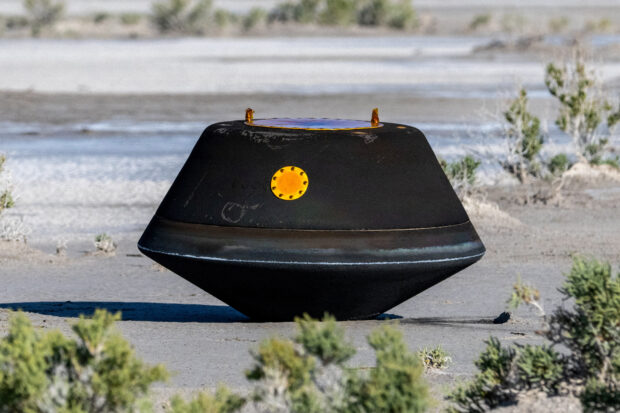FILE PHOTO: The return capsule containing a sample collected from the asteroid Bennu in October 2020 by NASA’s OSIRIS-REx spacecraft is seen shortly after touching down in the desert at the Department of Defense’s Utah Test and Training Range in Dugway, Utah, United States, September 24, 2023. NASA/Keegan Barber/Handout via REUTERS
NASA amazed the public on Wednesday by revealing the contents of a sealed capsule brought back to Earth last month. The capsule, which carried a carbon-rich soil sample taken from the surface of an asteroid, contained water-bearing clay minerals. The material was collected by the OSIRIS-REx spacecraft from the near-Earth asteroid Bennu three years ago and was unveiled at NASA’s Johnson Space Center in Houston. It was the largest asteroid sample, and only the third of its kind, returned to Earth for analysis.
During the event, NASA chief Bill Nelson introduced the first image of the material retrieved from Bennu. The picture showed a collection of charcoal-colored rocks, pebbles, and dust. These remnants were found in the outer part of the sample-collection assembly, left behind when the asteroid’s soil passed through a filter into the spacecraft’s storage canister. The inner science canister, which contains the majority of the specimen, is still being examined and is expected to take two more weeks to disassemble.
However, scientists were able to immediately study the “bonus” sample of overflow material using electron microscopes and X-ray instruments. Dante Lauretta, the principal mission investigator at the University of Arizona, revealed that the material contained a high percentage of carbon and water molecules locked in clay fibers. Iron minerals, indicative of formation in a water-rich environment, were also discovered.
The preliminary findings suggest that the material may be “loaded with organics,” according to Daniel Glavin, a senior sample scientist at NASA’s Goddard Space Flight Center. These findings support the hypothesis that celestial objects such as asteroids, comets, and meteorites may have delivered the essential ingredients for life to early Earth.
Bennu, discovered in 1999, is a loose clump of rocky material, similar to a rubble pile, held together by gravity. It measures about three-tenths of a mile (500 meters) across. This asteroid is scientifically invaluable as it provides insights into the origins and development of rocky planets like Earth.
The return capsule was first examined at the Utah Test and Training range before being transported to Houston for closer examination. The capsule is now housed in a specially built “clean room” at the Johnson Space Center. In the coming months, the overall asteroid sample will be distributed to laboratories around the world for further study.
The successful return of the Bennu sample is a significant milestone for NASA and sets the stage for future missions. As NASA prepares to launch a separate mission to the distant asteroid Psyche, the scientific community eagerly anticipates further discoveries that will expand our understanding of the solar system and potentially the origins of life itself.
Denial of responsibility! Vigour Times is an automatic aggregator of Global media. In each content, the hyperlink to the primary source is specified. All trademarks belong to their rightful owners, and all materials to their authors. For any complaint, please reach us at – [email protected]. We will take necessary action within 24 hours.


